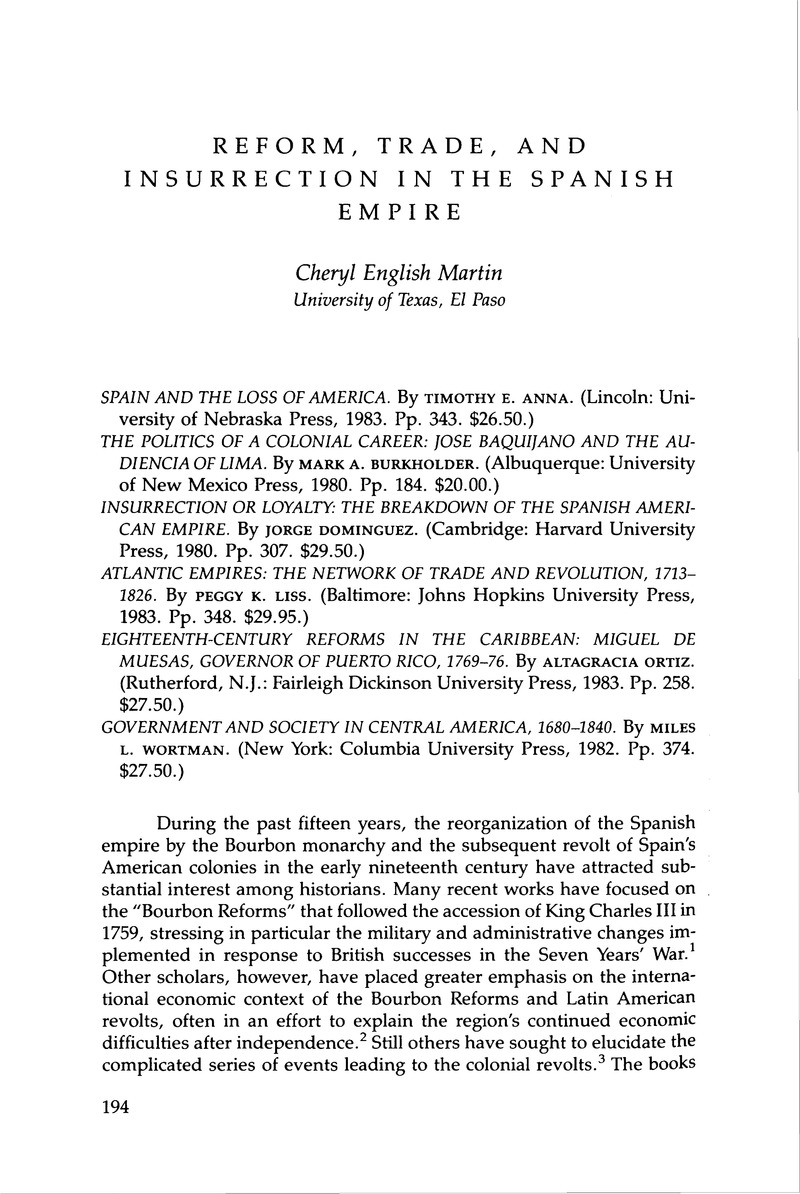No CrossRef data available.
Article contents
Reform, Trade, and Insurrection in the Spanish Empire
Review products
Published online by Cambridge University Press: 24 October 2022
Abstract

- Type
- Review Essays
- Information
- Copyright
- Copyright © 1984 by Latin American Research Review
References
Notes
1. A representative, but by no means exhaustive, sample of recent work emphasizing post-1763 reforms includes Nancy Farriss, Crown and Clergy in Bourbon Mexico: The Crisis of Ecclesiastical Privilege (London, 1968); David Brading, Miners and Merchants in Bourbon Mexico, 1763–1810 (Cambridge, 1971); Christon I. Archer, The Army in Bourbon Mexico (Albuquerque, 1977); Leon G. Campbell, The Military and Society in Colonial Peru, 1750–1810 (Philadelphia, 1978); Allan J. Keuthe, Military Reform and Society in New Granada, 1773–1808 (Gainesville, 1978); and Jacques Barbier, Reform and Politics in Bourbon Chile, 1755–1796 (Ottawa, 1980).
2. See, for example, Stanley J. Stein and Barbara H. Stein, The Colonial Heritage of Latin America: Essays on Economic Dependence in Historical Perspective (New York, 1970); Jonathan C. Brown, A Socioeconomic History of Argentina, 1776–1860 (London, 1979); Brian R. Hamnett, Politics and Trade in Southern Mexico, 1750–1821 (Cambridge, 1971); and Geoffrey J. Walker, Spanish Politics and Imperial Trade, 1700–1789 (Bloomington, 1979).
3. Timothy Anna, The Fall of the Royal Government in Mexico City (Lincoln, 1978), and The Fall of the Royal Government in Peru (Lincoln, 1979).
4. Mark Burkholder and D. S. Chandler, From Impotence to Authority: The Spanish Crown and the American Audiencias (Columbia, Mo., 1977); Leon G. Campbell, “A Colonial Establishment: Creole Domination of the Audiencia of Lima in the Late Eighteenth Century,” Hispanic American Historical Review 52 (1972): 1–25.
5. See, for example, Murdo J. MacLeod, Spanish Central America: A Socioeconomic History, 1520–1720 (Berkeley, 1973); Ralph Lee Woodward, Central America, A Nation Divided (New York, 1976); Mario Rodríguez, The Cádiz Experiment in Central America, 1808–1826 (Berkeley, 1978); Ralph Lee Woodward, “Economic and Social Origins of the Guatemalan Political Parties (1773–1823),” Hispanic American Historical Review 45 (1965): 544–66; and Robert S. Smith, “Indigo Production and Trade in Colonial Guatemala,” Hispanic American Historical Review 39 (1959): 182–211.
6. Review by Timothy E. Anna, The Americas 39 (1982): 141–43; review by Richard Graham, American Political Science Review 76 (1982): 163–64; and review by Peggy Liss, American Historical Review 86 (1981): 1177–78. For a generally favorable evaluation of the Domínguez study, see review by Hugh Hamill, Hispanic American Historical Review 61 (1981): 726–27.
7. Michael P. Costeloe, “Spain and the Latin American Wars for Independence: The Free Trade Controversy, 1810–1820,” Hispanic American Historical Review 61 (May 1981): 209–34; and “Spain and the Spanish American Wars for Independence: The Comisión de Reemplazos, 1811–1820,” Journal of Latin American Studies 13 (Nov. 1981): 223–37.


